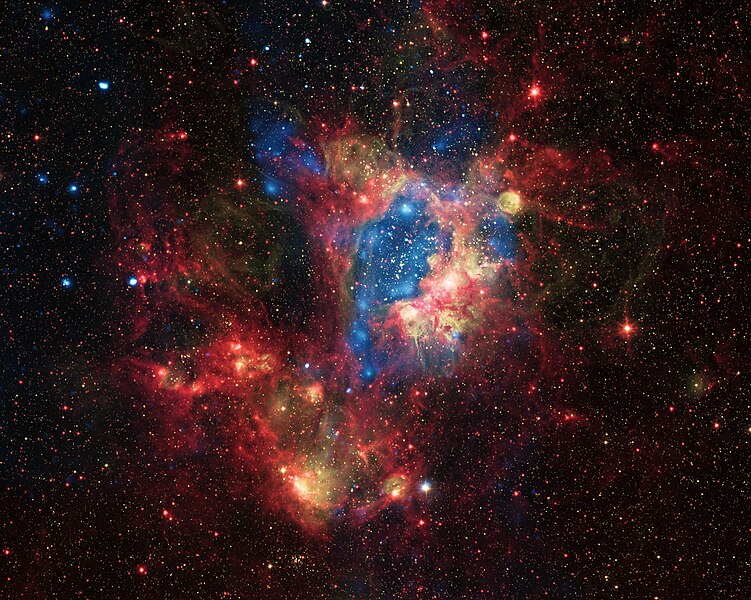ملف:LHA 120-N 44.jpg

الملف الأصلي (3٬600 × 2٬874 بكسل حجم الملف: 4٫06 ميجابايت، نوع MIME: image/jpeg)
| هذا ملف من ويكيميديا كومنز. معلومات من صفحة وصفه مبينة في الأسفل. كومنز مستودع ملفات ميديا ذو رخصة حرة. |
ملخص
| الوصفLHA 120-N 44.jpg |
English: This colourful new view shows the star-forming region LHA 120-N44 [1] in the Large Magellanic Cloud, a small satellite galaxy of the Milky Way. This picture combines the view in visible light from the MPG/ESO 2.2-metre telescope at ESO’s La Silla Observatory in Chile with images in infrared light and X-rays from orbiting satellite observatories.
At the centre of this very rich region of gas, dust and young stars lies the star cluster NGC 1929. Its massive stars produce intense radiation, expel matter at high speeds as stellar winds, and race through their short but brilliant lives to explode as supernovae. The winds and supernova shock waves have carved out a huge cavity, called a superbubble, in the surrounding gas. Observations with NASA's Chandra X-ray Observatory (shown here in blue) reveal hot regions created by these winds and shocks, while infrared data from NASA's Spitzer Space Telescope (shown in red) outline where the dust and cooler gas are found. The visible-light view from the MPG/ESO 2.2-metre telescope (in yellow) completes the picture and shows the hot young stars themselves as well as the glowing clouds of gas and dust that surround them. Combining these different views of this dramatic region has allowed astronomers to solve a mystery: why are N44, and similar superbubbles, giving off such strong X-rays? The answer seems to be that there are two extra sources of bright X-ray emission: supernova shock waves striking the walls of the cavities, and hot material evaporating from the cavity walls. This X-ray emission from the edge of the superbubble shows up clearly in the picture. Links Notes [1] The designation of this object indicates that it was included in the Catalogue of H-alpha emission stars and nebulae in the Magellanic Clouds, compiled and published in 1956 by American astronomer–astronaut Karl Henize (1926–1993). The letter “N” indicates that it is a nebula. The object is often called simply N44. |
| التاريخ | |
| المصدر | http://www.eso.org/public/images/potw1236a/ |
| المؤلف | Optical: ESO, X-ray: NASA/CXC/U.Mich./S.Oey, IR: NASA/JPL |
ترخيص
- يحقُّ لك:
- مشاركة العمل – نسخ العمل وتوزيعه وبثُّه
- إعادة إنتاج العمل – تعديل العمل
- حسب الشروط التالية:
- نسب العمل إلى مُؤَلِّفه – يلزم نسب العمل إلى مُؤَلِّفه بشكل مناسب وتوفير رابط للرخصة وتحديد ما إذا أجريت تغييرات. بالإمكان القيام بذلك بأية طريقة معقولة، ولكن ليس بأية طريقة تشير إلى أن المرخِّص يوافقك على الاستعمال.
الشروحات
العناصر المصورة في هذا الملف
يُصوِّر
٣ سبتمبر 2012
تاريخ الملف
اضغط على زمن/تاريخ لرؤية الملف كما بدا في هذا الزمن.
| زمن/تاريخ | صورة مصغرة | الأبعاد | مستخدم | تعليق | |
|---|---|---|---|---|---|
| حالي | 11:29، 3 سبتمبر 2012 |  | 3٬600 × 2٬874 (4٫06 ميجابايت) | Jmencisom | User created page with UploadWizard |
استخدام الملف
الصفحة التالية تستخدم هذا الملف:
الاستخدام العالمي للملف
الويكيات الأخرى التالية تستخدم هذا الملف:
- الاستخدام في de.wikipedia.org
- الاستخدام في en.wikipedia.org
- الاستخدام في fi.wikipedia.org
- الاستخدام في ru.wikipedia.org
بيانات وصفية
هذا الملف يحتوي على معلومات إضافية، غالبا ما تكون أضيفت من قبل الكاميرا الرقمية أو الماسح الضوئي المستخدم في إنشاء الملف.
إذا كان الملف قد عدل عن حالته الأصلية، فبعض التفاصيل قد لا تعبر عن الملف المعدل.
| المؤلف | Chandra X-ray Observatory Center |
|---|---|
| بيان حقوق التأليف والنشر على شبكة الإنترنت | |
| المصدر | European Southern Observatory |
| الرصيد/المزود | Optical: ESO, X-ray: NASA/CXC/U.Mich./S.Oey, IR: NASA/JPL |
| شروط الاستخدام |
|
| عنوان الصورة |
|
| عنوان قصير |
|
| تاريخ ووقت توليد البيانات | 10:00، 3 سبتمبر 2012 |
| الكلمات المفتاحية | LHA 120-N 44 |
| معلومات الاتصال | cxcpub@cfa.harvard.edu
Karl-Schwarzschild-Strasse 2 Garching bei München, , D-85748 Germany |
